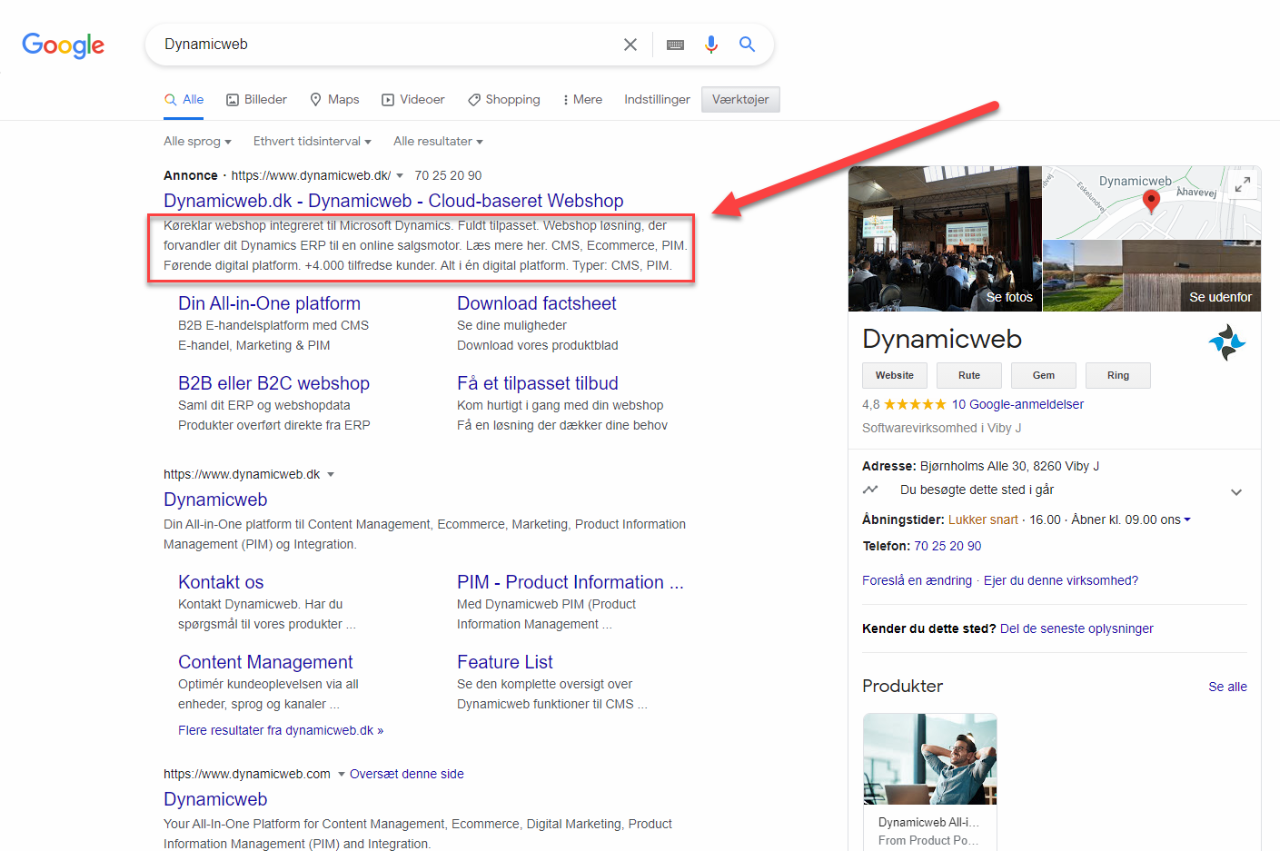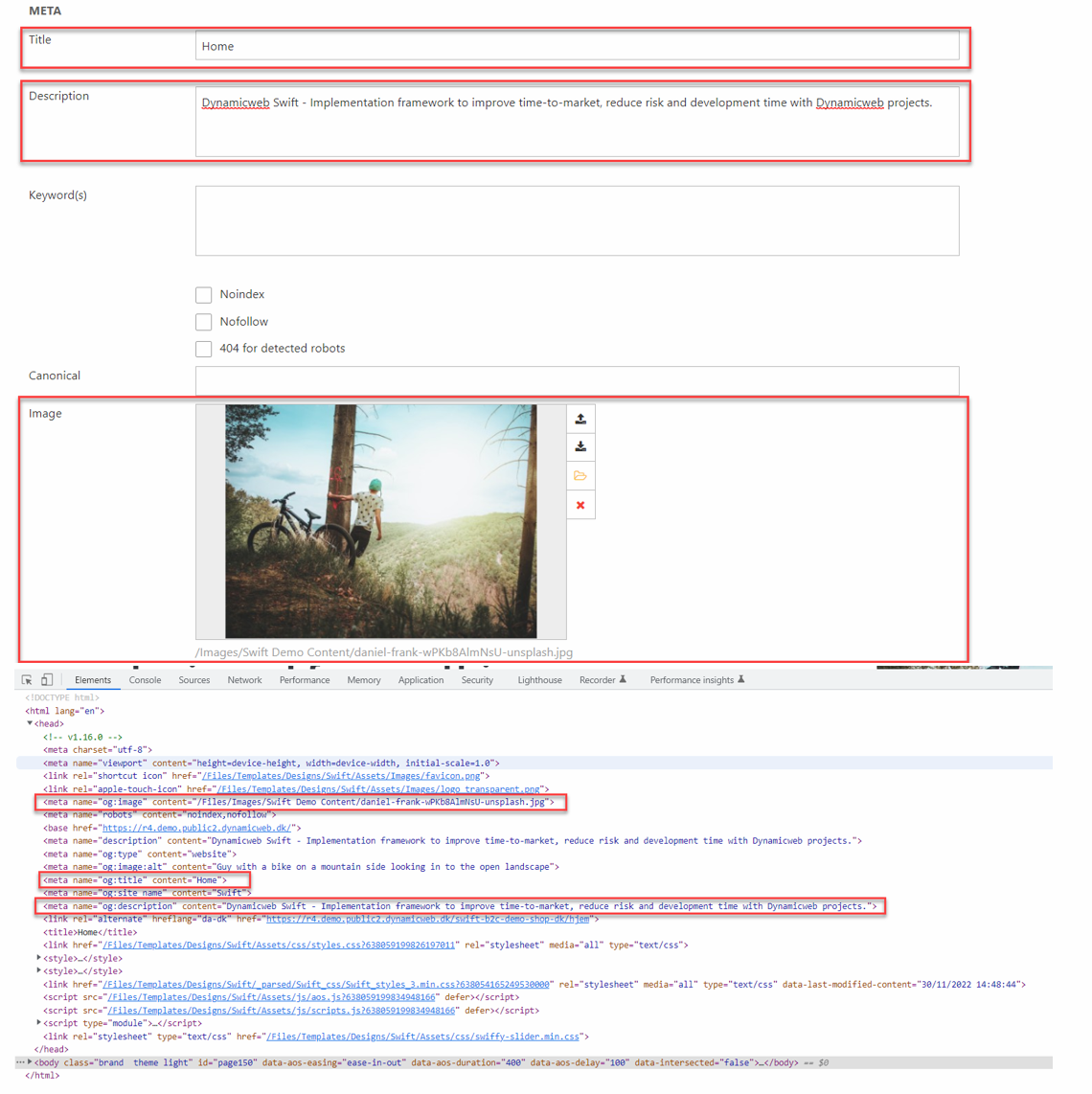Essential On-Page SEO
On-page SEO is the process of optimizing a page to improve how it ranks in search engines, leading to more relevant organic traffic. There are two main components to on-page SEO:
- Source code
- Content
For Dynamicweb Swift, we’ve got you covered when it comes to the source code – so you’re free to focus on what you do best, which is create awesome content.
Here is a list of things to focus on when it comes to on-page SEO on a Swift solution:
Page title
Good page titles are a very important factor for SEO, but what is a good page title?
First, the <title> tag – which is the important bit when it comes to SEO and page titles – is filled by the page name you give the page when you create it inside the backend. So, if you name the page Frontpage this is the values which is put in the <title>-tag.
But the question remains – how do you do write good page titles for both humans and search engines?
Some general advice is:
- Use keywords
If you’re writing about SEO – use SEO in the title. If your blog post is supposed to tell the world how great Trek bikes are – use the brand name Trek in the title. Very simple but often forgotten! - Divide the title into several parts
Many people enjoy more descriptive titles – like how to create SEO friendly titles for your website instead of simply Page titles & SEO. But be practical about it – it will work for a blog post, not for your main shop page. - Back up the title with relevant content
As always, you have to back up the title with actual relevant content, as a failure to engage with your visitors will lead to bad rankings.
Meta data
Many people believe meta data is extremely important when it comes to on-page SEO – in reality, it has been many years since search engines used meta data to rank pages in any meaningful way. What does still matter is the meta description, which is typically shown under the page title in search engines results Figure 3.1.

It is not that the meta description itself is used to rank the page – but a good meta description will lead people to click on the search result, and this will indirectly lead to a better ranking – Content is King. A good meta description includes some of the keywords you want to be associated with.
Meta descriptions are created under the page properties for a page – use the meta field Description. If your customers or boss insists you can also add keywords, but current consensus is that they don’t improve your ranking.
OpenGraph
The meta data created under the page properties for a page will also be used to create Open graph data. When filled out, the meta data in the source code, will also include an og: title, og:description and a og:image value. Again, these are all based on the input added in the page properties as seen on the Figure 4.1.

SEO-friendly URLs
The page URL is one of the first things search engines look at and the URL tells search engines which topic should be assessed and ranked on the website. Normally Dynamicweb generates an URL based on the page title – so the easiest way to ensure great URLs is by using great page titles.
If this is not possible for some reason you can set a specific URL via page settings – here’s how:
- Go to ‘Page properties’ in the same way as guided in the meta-description section above
- Enter a custom-URL in the Use in URL field
When you do:
- Keep the URL simple and “clean”
- Never use æ, ø or å because some search engines do not read these characters
- Avoid symbols and numbers
Headings & Content Structure
Another important area for increasing you google rank is headings – more specifically that they are structured in the correct order, with:
- A single H1 at the top of the page
- A number of H2s, H3s, & H4s in the correct order underneath
In Swift the heading-structure is auto-assigned. However, you can customize the heading-structure should you want to. This is done in the column editor on each specific content column in the section called Styling. You can choose between auto-assign or h1 to h6.
You can read more about each specific content column in our Content columns documentation.
Search engines typically also give the content of a heading high priority, so it’s important that the headings are descriptive of your content – some general guidelines are:
- Optimize headings by including keywords
- Use headings that describe the content
- Don’t use the same text for multiple headings
Text
Of course, good heading must be accompanied by good content – often text.
Here are 5 recommendations for writing good content:
- Focus on the reader and make the text interesting to read
- Use your keywords early in the text
- Focus on the number of words – try to have around 500 words between each new heading
- Supplement your content with illustrations, images, and video
- Create interest and/or the opportunity for interaction from the start
When writing your text focus on adding keywords, use synonyms, and alternate between different keywords so you don’t use the same keyword too many times. Remember our 5 recommendations when working with SEO and content and then you should be well on your way to create great content!
Likewise, here are 5 things to avoid:
- Avoid creating thin content – e.g. separate pages for bridal gowns, bridal dresses, wedding gowns & wedding dresses. This is not helpful to users and will not help your search engine ranking.
- Avoid duplicate content – don’t copy text from one page to another, don’t copy text from elsewhere and slightly modify it. Create original, helpful content.
- Avoid cloaking – adding hidden text not visible to a human visitor specifically to try to get a better search engine performance. This is actively punished by most search engines.
- Avoid keyword stuffing – writing the same critical keyword multiple times in a short text. Your text must be natural.
- Avoid auto-generated content. Just don’t do it, man. You’re better than this (and it also won’t help you).
Images & Videos
Another type of content which performs well with users (and therefore with search engines) is images & videos, with the main result being that it makes the visitor spend more time on a website which affects search engine ranking positively.
Here are some things to consider when it comes to image & video content:
- Set ALT-tags
Search engines are not capable of reading images, but will use the alt-tag on the image markup to categorize and rank a web page. Use short terms describing the image and relating to your overall site content. - Use descriptive filenames
Many people find content via e.g. Google image search – and content ranking for images is impacted by the file name, so you want to avoid file names such as IMG12359.jpg and use CannondaleEbike12359.jpg instead.
In Swift, alt-tags are set automatically for all product images – and for the column type Text and Image the title of the paragraph is used as the alt-text. Currently you cannot customize the alt-texts used.
Linkbuilding
One of the most important factors for google ranking is how crawlable a website is – and the thing which makes a website crawlable is linkbuilding, as links make it possible for search engine crawlers to find all your content.
Three types of linkbuilding are important for SEO:
- Internal links
Internal links are links between pages on the same website. For search engine crawlers, Internal links act as a kind of guide to your website – think of them as a way to specifically pass link equity (ranking power) to important pages on your website. Please note that links which require a click – like navigation links in a dropdown – are often hidden from search engine crawlers. Make sure important links are directly accessible on the landing page. - External inbound links
Just like an internal links share ranking power from the parent page to the target page, external links to your website from highly ranked websites and pages will grant your page ranking power. - External outbound links
While it’s common knowledge that internal links and external inbound links are crucial for SEO, the value of external outbound links is less known but equally important – primarily because outbound links to relevant content will boost your reputation as a useful website and help you appear as an authority on a subject. The values, then, is not one of shared ranking power but of quality content.
